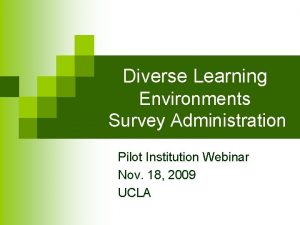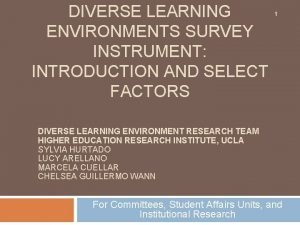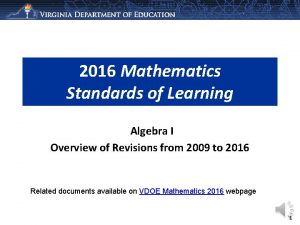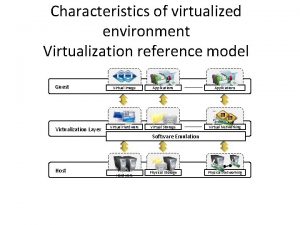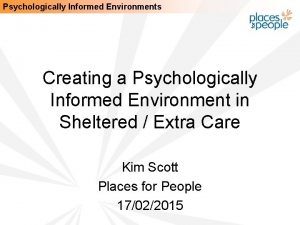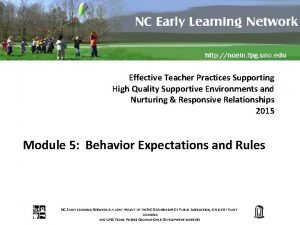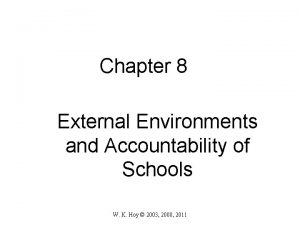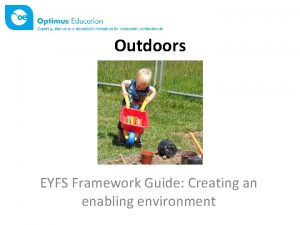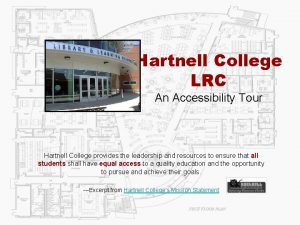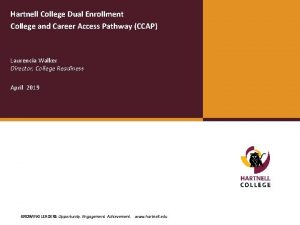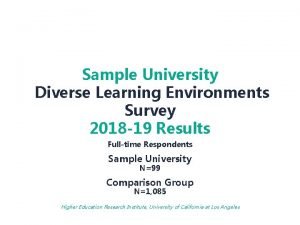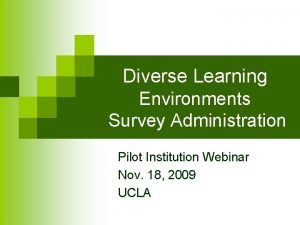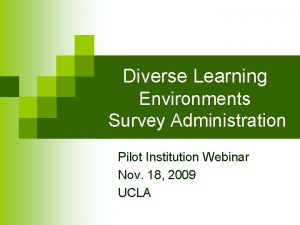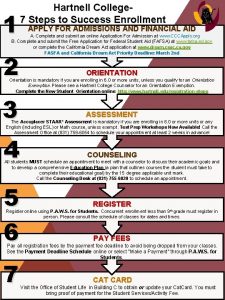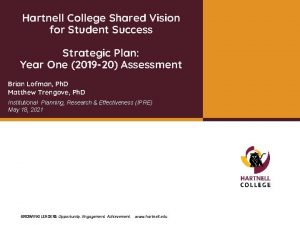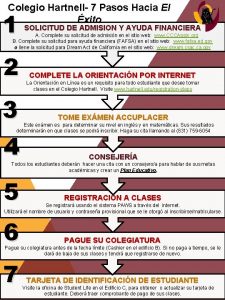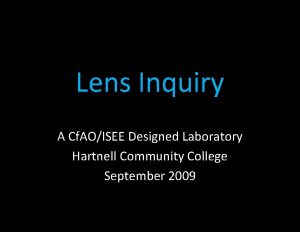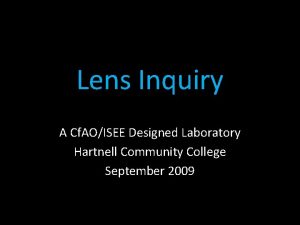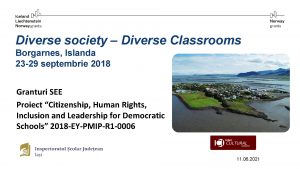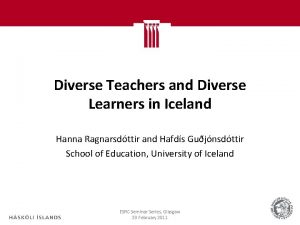Hartnell College Diverse Learning Environments Survey 2016 17































- Slides: 31

Hartnell College Diverse Learning Environments Survey 2016 -17 Results Full-time Respondents Hartnell College N=576 Public 2 yr Colleges N=2, 443 Higher Education Research Institute, University of California at Los Angeles Return to contents

Table of Contents • • Demographics Sex/Gender Identity Class Year/Credits Completed Race/Ethnicity Full/Part-time • Co-Curricular Diversity Activities Navigational Action • Campus Climate Sense of Belonging Academic Validation General Interpersonal Validation Institutional Commitment to Diversity Positive Cross-Racial Interaction Negative Cross-Racial Interaction Discrimination and Bias Harassment Conversations Across Difference 2016 -17 Diverse Learning Environments Survey Institutional Practices Curriculum of Inclusion Student Learning Outcomes Habits of Mind Integration of Learning Academic Self-Concept Pluralistic Orientation Civic Engagement 2

EMBRACING DIVERSITY PROMOTES The First Year is Important… STUDENT SUCCESS Results from the Diverse Learning Environments Survey (DLE) can be used to assess the impact of the environments that help shape learning, providing important information on the intersection of: • Campus Climate • Institutional Practices • Student Learning Outcomes 2016 -17 Diverse Learning Environments Survey Return to contents 3

A Note about HERI Factors HERI uses Factors throughout this Power. Point to help summarize important information about your students from the DLE. Factors use confirmatory factor analysis to aggregate the results from CIRP questions that tap into key aspects of the college experience. They focus on student traits and institutional practices contributing to students’ academic and social development. 2016 -17 Diverse Learning Environments Survey Return to contents 4

Demographics 2016 -17 Diverse Learning Environments Survey Return to contents

Demographics Sex Gender Identity 0, 2% Man 31, 1% 67, 3% Woman 31, 8% 68, 1% Trans man 0, 2% Trans woman 0, 0% Genderqueer/. . . 1, 1% Different identity 0, 4% Male Female Other 2016 -17 Diverse Learning Environments Survey Return to contents 6

Demographics Credits Completed 7, 2% 16, 0% 36, 6% 0 -24 25 -59 40, 2% 2016 -17 Diverse Learning Environments Survey Return to contents 7

Demographics Race/ Ethnicity American Indian or Alaska Native Hawaiian or Other Pacific Islander East Asian Filipino Southeast Asian South Asian Other Asian African American/Black African Caribbean Other Black European Middle Eastern Other White Mexican American/Chicano Puerto Rican Central American Other Hispanic or Latino 3, 1% 1, 7% 3, 0% 6, 8% 0, 7% 0, 2% 0, 3% 2, 4% 0, 3% 0, 5% 0, 3% 10, 8% 0, 7% 3, 6% 73, 1% 0, 9% 1, 9% 7, 6% 0% 2016 -17 Diverse Learning Environments Survey 20% 40% % of Students 60% Return to contents 80% 8

Demographics Race/Ethnicity Group 0, 5% American Indian 5, 4% Asian 20, 4% 1, 0% 4, 3% Black 0, 5% Hawaiian 74, 1% Hispanic (any race) 41, 3% 6, 9% White 19, 3% 10, 4% 12, 6% Two or more 1, 0% 1, 1% Unknown 0% 10% 20% 30% 40% 50% 60% 70% 80% % of Students Your Institution 2016 -17 Diverse Learning Environments Survey Comparison Group Return to contents 9

Campus Climate The social and psychological climate on campus can impact students’ ability to benefit from their educational environment and their academic success. 2016 -17 Diverse Learning Environments Survey Return to contents

Sense of Belonging The campus community is a powerful source of influence on students’ development. Sense of Belonging measures the extent to which students feel a sense of academic and social integration on campus. 100 90 Items 80 70 60 51, 1 50, 4 50, 1 50 50, 9 50, 6 40 30 20 • I feel a sense of belonging to this campus • I feel I am a member of this college • I see myself as part of the campus community • If asked, I would recommend this college to others 10 0 All FT Men ■ Your Institution 2016 -17 Diverse Learning Environments Survey Women Comparison Group Return to contents 11

Academic Validation Faculty interactions in the classroom can foster students’ academic development. Academic Validation measures students’ views of the extent to which faculty actions in class reflect concern for their academic success. 100 Items 90 80 70 60 52, 1 52, 0 51, 9 52, 0 52, 2 50 40 30 20 10 0 All FT Men ■ Your Institution 2016 -17 Diverse Learning Environments Survey Women Comparison Group • Felt that my contributions were valued in class • Felt that faculty provided me with feedback that helped me assess my progress in class • Felt that faculty encouraged me to ask questions and participate in class discussions • Faculty were able to determine my level of understanding of course material Return to contents 12

General Interpersonal Validation is a unified measure of students’ view of faculty and staff’s attention to their development. 100 Items 90 80 70 60 51, 7 50, 8 50 40 30 20 10 0 All FT Men ■ Your Institution 2016 -17 Diverse Learning Environments Survey Women • At least one faculty member has taken an interest in my development • Faculty believe in my potential to succeed academically • At least one staff member has taken an interest in my development • Staff recognize my achievements • Faculty empower me to learn here • Staff encourage me to get involved in campus activities Comparison Group Return to contents 13

Institutional Commitment to Diversity is a measure of a student’s perception of the campus’ commitment to diversity. 100 90 Items 80 • Promotes appreciation of cultural differences • Has a long-standing commitment to diversity • Accurately reflects the diversity of the student body in publications (e. g. , brochures, website, etc. ) • Has campus administrators who regularly speak about the value of diversity 70 60 50 47, 3 47, 8 47, 9 47, 3 47, 0 48, 0 40 30 20 10 0 All FT Men ■ Your Institution 2016 -17 Diverse Learning Environments Survey Women Comparison Group Return to contents 14

Positive Cross-Racial Interaction Contact with diverse students allows students to gain valuable insights about themselves and others. Positive Cross-Racial Interaction is a unified measure of students’ level of positive interaction with diverse peers. 100 90 Items 80 • Had intellectual discussions outside of class • Shared personal feelings and problems • Dined or shared a meal • Had meaningful and honest discussions about race/ethnic relations outside of class • Socialized or partied 70 60 50 47, 2 47, 3 47, 2 46, 8 47, 2 40 30 20 10 0 All FT ■ Your Institution 2016 -17 Diverse Learning Environments Survey Men Women Comparison Group Return to contents 15

Negative Cross-Racial Interaction Contact with diverse students allows students to gain valuable insights about themselves and others. Negative Cross-Racial Interaction is a unified measure of students’ level of negative interaction with diverse peers. 100 90 Items 80 70 60 50 50, 2 48, 8 50, 4 49, 1 50, 1 48, 7 40 30 20 • Had tense, somewhat hostile interactions • Felt insulted or threatened because of my race/ethnicity • Had guarded, cautious interactions 10 0 All FT ■ Your Institution 2016 -17 Diverse Learning Environments Survey Men Women Comparison Group Return to contents 16

Discrimination and Bias measures the frequency of students’ experiences with more subtle forms of discrimination. Items 100 90 80 70 60 50 45, 4 45, 7 45, 0 45, 3 45, 2 44, 9 40 30 20 10 0 All FT Men Women ■ Your Institution Comparison Group 2016 -17 Diverse Learning Environments Survey • Verbal comments • Witnessed discrimination • Written comments (e. g. , emails, texts, writing on walls) • Heard insensitive or disparaging remarks from faculty • Heard insensitive or disparaging remarks from students • Exclusion (e. g. , from gatherings, events) • Heard insensitive or disparaging remarks from staff • Offensive visual images or items Return to contents 17

Harassment measures the frequency that students experience threats or harassment. Items 100 90 80 70 60 50 49, 2 49, 8 48, 3 49, 1 48, 9 48, 0 40 30 20 10 0 All FT Men ■ Your Institution 2016 -17 Diverse Learning Environments Survey • Physical assaults or injuries • Threats of physical violence • Anonymous phone calls • Damage to personal property • Reported an incident of sexual harassment to a campus authority • Reported an incident of discrimination to a campus authority • Experienced sexual harassment Women Comparison Group Return to contents 18

Conversations Across Difference Students who engage with diverse peers are more likely to achieve change across a wide range of student learning outcomes. Items 100 90 80 70 60 50 44, 2 47, 3 46, 6 44, 7 43, 9 47, 6 40 30 20 10 • From a socioeconomic class different from your own • From a religion different from your own • Of a sexual orientation different from your own • From a country other than your own • With a disability • Discuss issues related to sexism, gender differences or gender equity 0 All FT Men ■ Your Institution 2016 -17 Diverse Learning Environments Survey Women Comparison Group Return to contents 19

Institutional Practices Guided and intentional campus practices that create opportunities for interaction among a diverse student body help students become active agents in their own learning. 2016 -17 Diverse Learning Environments Survey Return to contents

Curriculum of Inclusion Pedagogy and course content resonate with students’ identities and help students feel valued and affirmed as learners. Curriculum of Inclusion measures the number of courses a student has taken that include materials and pedagogy addressing diversity. 100 90 80 70 60 50 46, 5 48, 0 48, 2 47, 0 46, 2 48, 0 40 30 20 10 0 All FT Men ■ Your Institution 2016 -17 Diverse Learning Environments Survey Women Comparison Group Items • Materials/readings about race/ethnicity • Materials/readings about socioeconomic class differences • Materials/readings about privilege • Materials/readings about sexual orientation • Materials/readings about gender • Opportunities for intensive dialogue between students with different backgrounds and beliefs • Materials/readings about disability • Opportunities to study and serve communities in need Return to contents 21

Co-Curricular Diversity Activities is a measure of students’ involvement with institutional programs focused on diversity issues. Items 100 90 80 70 60 50 48, 4 47, 3 47, 6 47, 8 47, 1 40 30 20 10 0 All FT Men ■ Your Institution 2016 -17 Diverse Learning Environments Survey Women • Participated in ongoing campus organized discussions on racial/ethnic issues (e. g. , intergroup dialogue) • Attended programs focused on diversity (e. g. , presentations, performances, art exhibits, debates) • Participated in Campus Center activities (e. g. , LGBTQ, Racial/Ethnic, Cultural, Women’s/Men’s, Religious, Disability Centers) Comparison Group Return to contents 22

Navigational Action These items illustrate how often students participated in institutional programs or engaged in activities that would help them successfully traverse the institution. 100% 90% 80% 70% 60% 24, 9% 23, 7% 50% 40% 10, 2% 9, 5% 30, 1% 32, 3% 30% 20% 48, 2% 48, 0% 10% 0% Academic Advising Average (Frequently) Hartnell: 19% All Institutions: 16% Includes in. Environments next chart 2016 -17 Diverseitems Learning Survey 6, 2% 4, 0% 13, 9% 16, 0% Campus Safety Services Your Institution Group Frequently Occasionally Writing Center Comparison Frequently Occasionally Return to contents 23

Navigational Action These items illustrate how often students participated in institutional programs or engaged in activities that would help them successfully traverse the institution. 100% 90% 80% 70% 60% 29, 5% 27, 3% 25, 8% 12, 1% 20, 8% 50% 40% 30% 20% 47, 6% 50, 3% 40, 2% 46, 5% 53, 9% 51, 8% 10% 0% Financial Aid Advising Average (Frequently) Hartnell: 19% All Institutions: 16% Includes items from prior 2016 -17 Diverse Learning Environments chart Survey Career Counseling Your Institution Group Frequently Occasionally Attended Professors’ Office Hours Comparison Frequently Occasionally Return to contents 24

Student Learning Outcomes Students develop across a range of outcomes related to complex thinking, ethical decision-making, and capacity for citizenship when they are exposed to diversity. 2016 -17 Diverse Learning Environments Survey Return to contents

Habits of Mind is a unified measure of the behaviors and traits associated with academic success. These learning behaviors are seen as the foundation for lifelong learning. 100 Items 90 80 70 60 50 47, 8 50, 4 49, 2 47, 1 48, 6 40 30 20 10 0 All FT Men ■ Your Comparison 2016 -17 Diverse Learning Environments Survey Women • Seek solutions to problems and explain them to others • Evaluate the quality or reliability of information you received • Support your opinion with a logical argument • Seek alternative solutions to problems • Take a risk because you feel you have more to gain • Ask questions in class • Explore topics on your own, even though it was not required for a class • Accept mistakes as part of the learning process Group Institution Return to contents 26

Integration of Learning How often in the past year did you: (% Indicating “Frequently” or “Occasionally”) 100% 90% 80% 70% 41, 6% 44, 9% 42, 4% 44, 5% 50, 4% 54, 9% 45, 6% 45, 1% 45, 2% 44, 0% 41, 6% 40, 4% 60% 50% 40% 30% 20% 10% 0% Apply concepts from courses to real life situations Average (Frequently) Hartnell: 45% All Institutions: 48% 2016 -17 Diverse Learning Environments Survey Use different points of view to make an argument Your Institution Group Frequently Occasionally Analyze multiple sources of information before coming to a conclusion Comparison Frequently Occasionally Return to contents 27

Academic Self-Concept Self-awareness and confidence in academic environments help students learn by encouraging their intellectual inquiry. Academic Self-Concept is a unified measure of students’ beliefs about their abilities and confidence in academic environments. 100 Items 90 80 70 60 50 50, 0 49, 9 52, 6 51, 4 48, 8 49, 2 • Self-rated academic ability • Self-rated intellectual selfconfidence • Self-rated drive to achieve • Self-rated mathematical ability 40 30 20 10 0 All FT Men ■ Your Institution 2016 -17 Diverse Learning Environments Survey Women Comparison Group Return to contents 28

Pluralistic Orientation measures skills and dispositions appropriate for living and working in a diverse society. 100 Items 90 80 70 60 50, 5 50, 3 52, 2 50, 7 50 49, 7 50, 2 40 30 • Tolerance of others with different beliefs • Openness to having my views challenged • Ability to work cooperatively with diverse people • Ability to discuss and negotiate controversial issues • Ability to see the world from someone else's perspective 20 10 0 All FT Men ■ Your Institution 2016 -17 Diverse Learning Environments Survey Women Comparison Group Return to contents 29

Civic Engagement Engaged citizens are a critical element in the functioning of our democratic society. Civic Engagement measures the extent to which students are motivated and involved in civic, electoral, and political activities. Items 100 • Demonstrated for a cause • Publicly communicated your opinion about a cause • Discussed politics • Performed community service 90 80 70 60 50 47, 6 46, 6 48, 0 47, 3 46, 2 40 30 20 10 0 All FT Men ■ Your Institution 2016 -17 Diverse Learning Environments Survey Women Comparison Group Return to contents 30

Connections between climate, institutional practices and outcomes can foster success. For more information about HERI/CIRP Surveys The Freshman Survey Your First College Year Survey Diverse Learning Environments Survey College Senior Survey The Faculty Survey Staff Climate Survey 2016 -17 Diverse Learning Environments Survey Please contact: heri@ucla. edu (310) 825 -1925 www. heri. ucla. edu Return to contents 31
 Diverse learning environments survey
Diverse learning environments survey Diverse learning environments survey
Diverse learning environments survey Diversity among protoctista
Diversity among protoctista Paul lee stine
Paul lee stine Jonassen constructivism
Jonassen constructivism Acls abcd
Acls abcd Cuadro comparativo e-learning b-learning m-learning
Cuadro comparativo e-learning b-learning m-learning 2016 algebra 1 sol
2016 algebra 1 sol 2016 mathematics standards of learning
2016 mathematics standards of learning 2016 cengage learning
2016 cengage learning International business environments and operations
International business environments and operations Characteristics of server virtualization
Characteristics of server virtualization Business environment
Business environment Chapter 13 natural environments of europe
Chapter 13 natural environments of europe Stable prediction across unknown environments
Stable prediction across unknown environments Psychologically informed environments
Psychologically informed environments Psychologically informed environments
Psychologically informed environments Creating supportive environments smoking
Creating supportive environments smoking High quality supportive environments
High quality supportive environments External environments and accountability of schools
External environments and accountability of schools Known vs unknown environment
Known vs unknown environment Chapter 13 natural environments of europe
Chapter 13 natural environments of europe Chapter 7 natural environments of north america
Chapter 7 natural environments of north america Why are cold environments under threat
Why are cold environments under threat Interrelationship between micro and macro environment
Interrelationship between micro and macro environment Ans0361i
Ans0361i Actors in marketing environment
Actors in marketing environment Implations
Implations Different environments
Different environments The marketing environment
The marketing environment International business chapter 5
International business chapter 5 Enabling environments eyfs
Enabling environments eyfs
